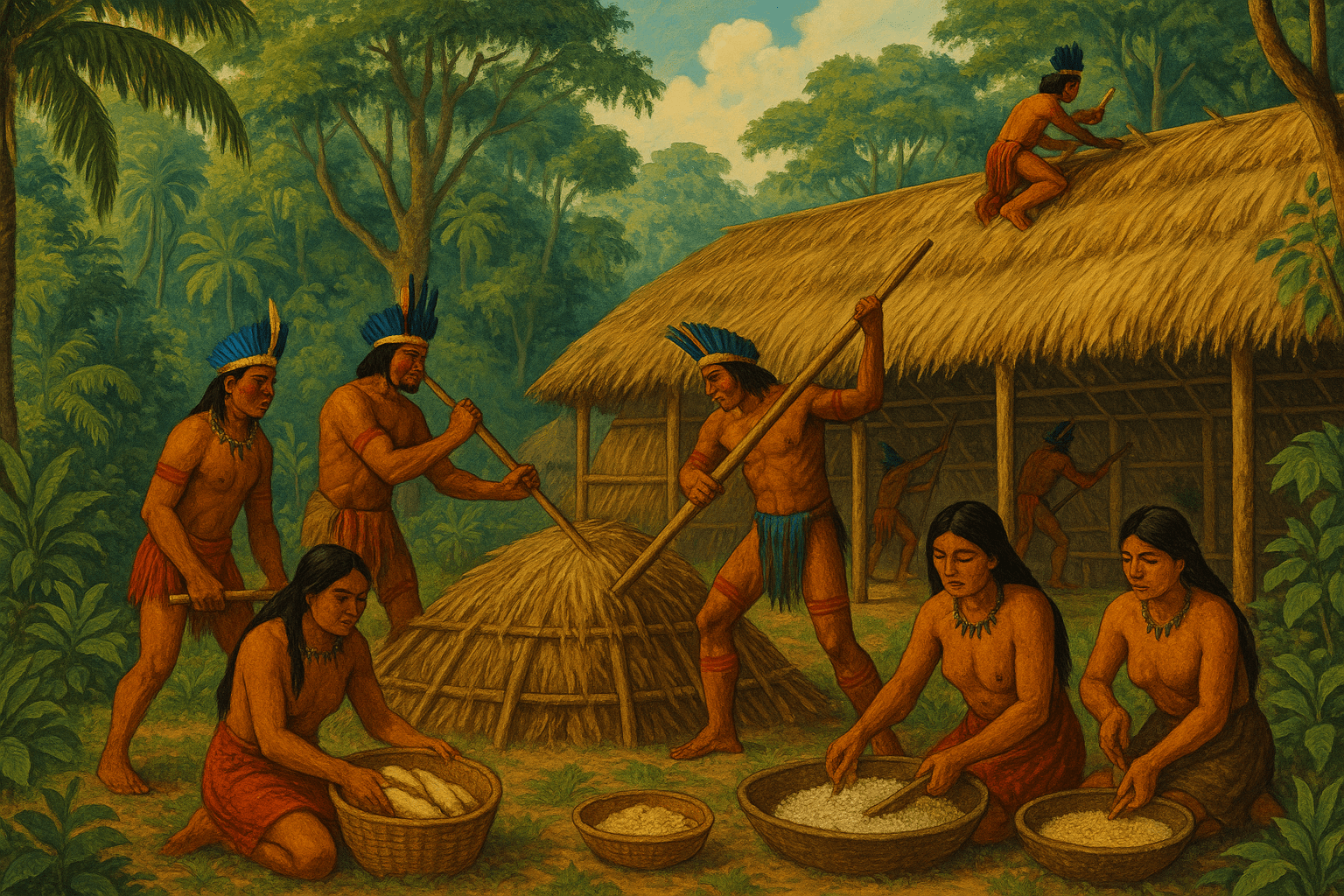A World of Longhouses and Manioc
The Tupi were not a unified empire like the Inca or Aztec. They were a linguistic family, divided into numerous rival groups such as the Tupinambá, the Potiguara, and the Tupiniquim. Their world was centered on the village. A typical Tupi settlement was a formidable sight: a collection of four to eight enormous communal longhouses, known as malocas, arranged around a central plaza. Each maloca could house hundreds of people, all related by kinship, under a single thatched roof. These villages were often fortified with tall wooden palisades, a clear sign that life was far from peaceful.
Daily life was intricately tied to the environment. The Tupi were master horticulturalists, their primary crop being the versatile and hardy manioc (cassava). Women were the cultivators, responsible for planting, harvesting, and processing the poisonous root into edible flour (farinha), bread, and fermented beverages. This agricultural base was supplemented by the work of men, who were the hunters, fishermen, and, most importantly, the warriors. The spiritual life of the community was guided by shamans, known as pajés, who were believed to communicate with the spirit world, heal the sick, and predict the future.
“I Am Your Food”: The Logic of Ritual Warfare and Cannibalism
Perhaps the most famous—and most misunderstood—aspect of Tupi culture was their practice of ritual warfare and cannibalism. European observers, from missionaries to shipwrecked sailors, were horrified by what they saw, labeling it as savage and barbaric. The reality, however, was far more complex and embedded in a deep sense of honor, revenge, and cosmic balance.
Tupi warfare was not primarily about conquering land or seizing resources. Instead, it was a perpetual cycle of blood feuds between rival groups. The main goal of a raid was not to kill the enemy on the battlefield, but to capture a respected warrior. Capturing an enemy alive brought immense prestige to the warrior and his community.
The prisoner’s fate was surreal. Upon arrival at the captor’s village, he was not immediately killed. Instead, he was treated as an ambiguous guest of honor. He might live for months, or even years, within the community. He was given a wife from the village, fed the best food, and allowed to participate in daily life. Yet, his doom was sealed. This period of waiting was a test of his courage and a way for the captors to “domesticate” his spirit before the final ritual.
The German sailor Hans Staden, who was captured by the Tupinambá in the 1550s and miraculously survived, provided a chilling firsthand account of the ceremony. When the day came, the captive was led to the central plaza, adorned with feathers, and allowed to taunt his captors. The execution was a public spectacle. The captive was expected to die bravely, proclaiming his valor and promising that his people would avenge him. His final words were often a defiant cry of, “I am your food!”
The act of eating the enemy, or antropofagia, was not about hunger. It was a profoundly spiritual and social act. By consuming parts of a brave warrior, the Tupi believed they could absorb his strength, courage, and spirit, thus strengthening their own community while simultaneously enacting the ultimate form of revenge.
Collision and Catastrophe
The arrival of the Portuguese in 1500 shattered the Tupi world. Initially, relations were based on trade. The Tupi offered Brazilwood, a valuable source of red dye, in exchange for European metal tools, fabrics, and trinkets. However, as the Portuguese ambition shifted from trade to colonization and the establishment of vast sugar plantations, the demand for land and labor skyrocketed.
What followed was a demographic catastrophe. The Portuguese exploited the Tupi’s existing rivalries, forming alliances with groups like the Tupiniquim to wage war against their enemies, the Tupinambá. But the most lethal invaders were invisible. European diseases like smallpox, measles, and influenza, to which the indigenous population had no immunity, swept through villages, killing up to 90% of the population in some areas. Those who survived were often forced into brutal slavery on the sugar plantations. Within a century, the vibrant Tupi societies that had lined the coast were decimated, their survivors either assimilated or pushed deep into the Amazonian interior.
The Tupi Echo in Modern Brazil
While the Tupi people were physically displaced and their societies destroyed, their culture did not vanish. Instead, it became a foundational, and often unacknowledged, pillar of modern Brazil.
The most tangible legacy is linguistic. For centuries, a simplified Tupi-based trade language known as Nheengatu (the “Good Language”) was the lingua franca of Brazil, spoken by Indigenous people, African slaves, and European colonists alike. Today, Brazilian Portuguese is saturated with thousands of Tupi words. This influence is everywhere:
- Place Names: Rio de Janeiro’s famous beaches, Ipanema (“bad water”) and Copacabana (“mirador of the blue expanse”), and the bay it sits on, Guanabara (“lagoon-sea”).
- Fauna and Flora: Everyday words for native wildlife and plants are overwhelmingly Tupi, including jacaré (alligator), capivara (capybara), caju (cashew), and abacaxi (pineapple).
- Food & Culture: Staples of Brazilian cuisine like tapioca and farinha de mandioca come directly from Tupi agriculture. Even common words like pipoca (popcorn) have Tupi roots.
Beyond language, Tupi culture permeates Brazilian folklore, with mythical beings like the forest-protector Curupira and the fiery serpent Boitatá remaining popular figures. In the 19th century, Brazilian artists and writers of the Romantic movement embraced the image of the “noble Tupi warrior” as a symbol of Brazil’s unique national identity, distinct from its colonial Portuguese past.
The story of the Tupi is a classic tale of first contact, misunderstanding, and tragedy. But it is also a story of incredible resilience. Though their malocas no longer line the coast, the spirit, language, and culture of the Tupi people are woven into the very fabric of Brazil, a ghostly but powerful echo from a world that was lost but not entirely erased.
